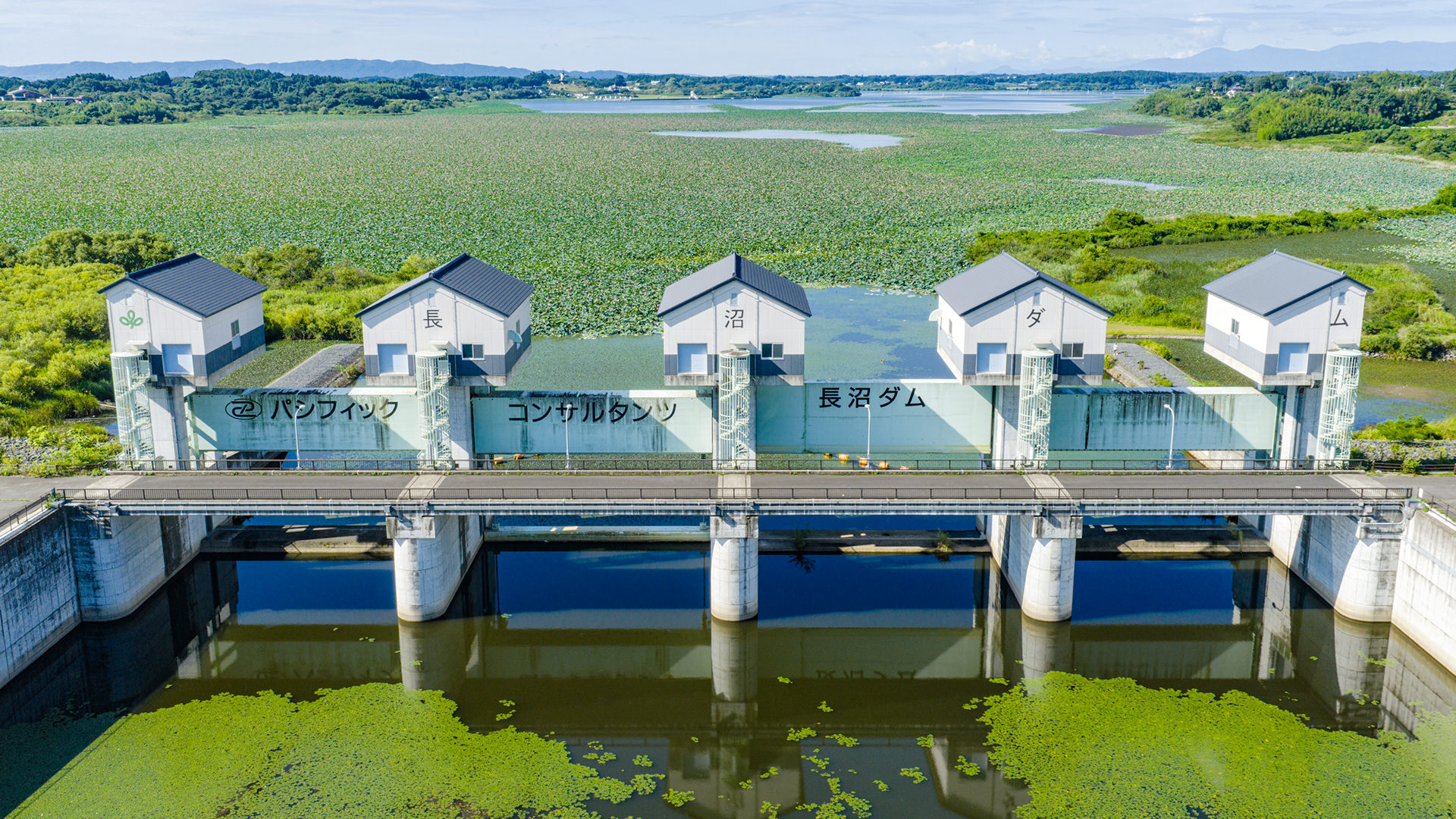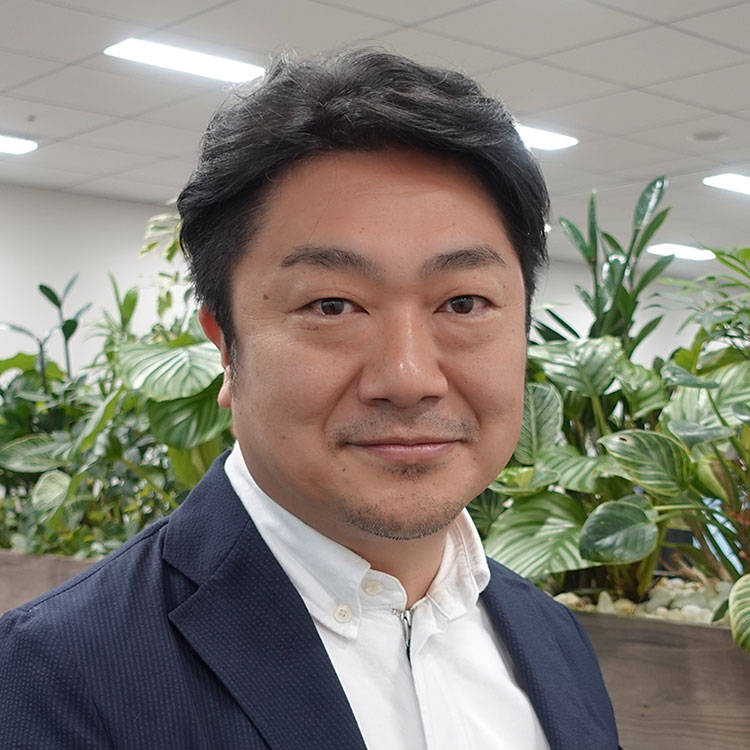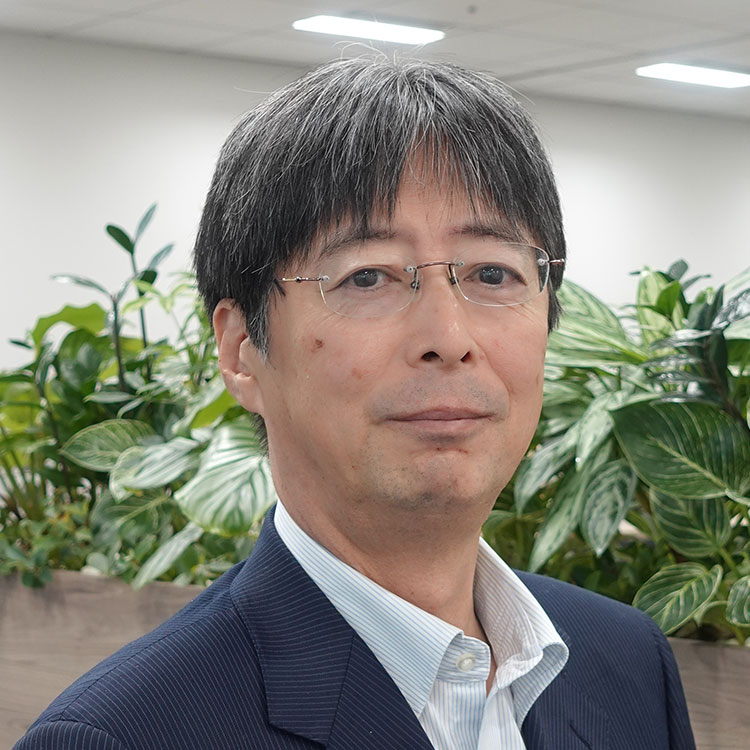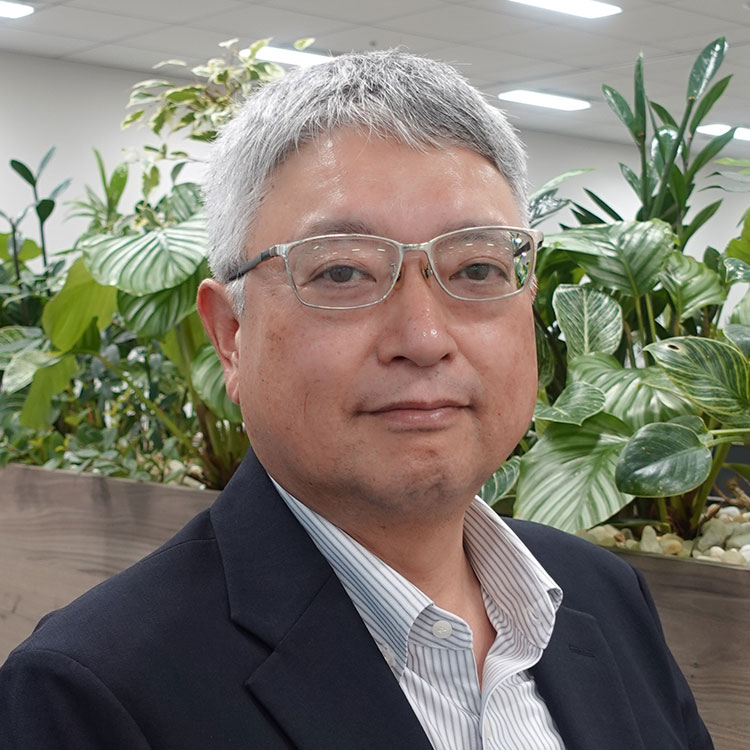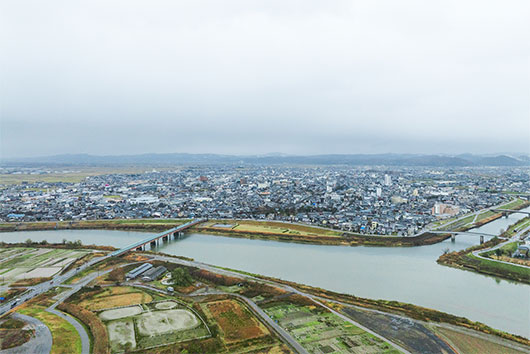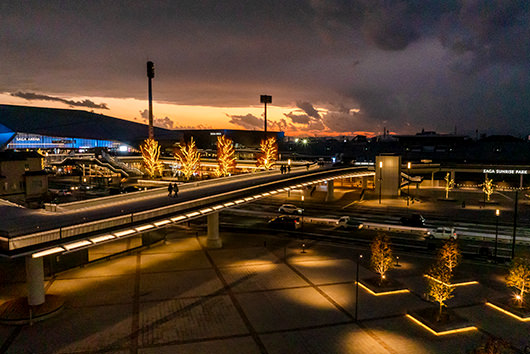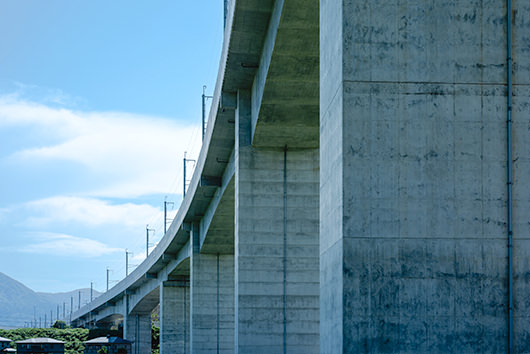The Hasama River, a Class A river in northern Miyagi Prefecture, frequently floods and is nicknamed the "Wild River." In 1971, a comprehensive flood control plan was drawn up to build 10 dams and one retarding basin, with Naganuma Dam, which utilizes natural lakes and marshes, at the center of the plan. However, the surrounding area is low-lying marshland with continuous soft ground. No dam had ever been built on such soft ground before. Four people who supported this difficult construction project, which lasted 40 years, from planning to completion: Tetsuo KOMORIYA, General Manager of Renewable Energy Promotion/Development Sec., River Basin Structural Dept., Land Infrastructure Div.; Takehiko HIRATSUKA in the Dams and Erosion Control Sec. of the same department; Atsushi FUNAYAMA, Geotechnical Engineering Dept. of the same division; and Ken OKAYA in the Tohoku Land Infrastructure Dept., look back on the efforts.
INDEX
- Flood protection by damming natural lakes and ponds
- Japan's first attempt to build a dam on soft ground
- How to design a multi-function floodgate
- It sinks and rises, rises and sinks
- Effectiveness demonstrated during heavy rainfall immediately after operation began
- It also serves as a stable source of water for agriculture and a recreational space for citizens
- The project progressed while creating standards
Flood protection by damming natural lakes and ponds
The Hasama River, which originates in the Kurikoma Mountains, is known as a difficult river to control due to the fact that many rivers flowing down the steep mountains converge downstream at a gentler gradient. Shortly after the war, Typhoon Kathleen in 1947, Typhoon Ion the following year, and heavy rains in the summer of 1950 caused serious flood damage in succession, leading to the construction of the Hanayama Dam and Kurikoma Dam in the upstream area, but flood damage continued downstream even after that. As a result, the Hasama River Comprehensive Development Project was formulated in 1971, and a comprehensive flood control plan was put into action involving a total of 10 dams, including existing dams, and the Minamiyachi Reservoir. Naganuma Dam was the core of this plan.
Although it is called a dam, Naganuma Dam is quite different from what one would normally imagine from its name. Dams generally block and store water flowing in from upstream, regulating the amount of water that flows downstream, but Naganuma Dam diverts floodwater from the Hasama River through a 580m-wide overflow dike and stores it in Naganuma via a 2.7km-long headrace channel, preventing flooding downstream of the Hasama River. When the water level downstream drops, the water stored in Naganuma is allowed to flow back up the channel and returned to the river. The idea is to turn a natural lake into a dam and use it as a buffer to regulate the river's water level.


Source: Miyagi Prefecture's documents
As a result, Naganuma Dam's overall structure and facilities were complex. It required an overflow dike on the Hasama River, a long waterway leading from it, sluice gates to serve as the entrance and exit points for Naganuma's water, a main dam 15.3 meters high and 1,050 meters long to ensure an effective storage capacity of approximately 30 million cubic meters, and further machinery and sluice gates to return the water to the river. There was also the issue of how to ensure that the dam would continue to fulfill its role as a water source for the surrounding rice paddies. And that's not all. The area is a marshy area dotted with swamps and has continuous soft ground. To begin with, there was no precedent for building a dam there, even in the long history of dam construction.
Japan's first attempt to build a dam on soft ground
PACIFIC CONSULTANTS was the company that was entrusted with the Naganuma Dam construction project, which was expected to be a difficult construction. "I joined the company in 1983, but the project had already begun," HIRATSUKA recalls. HIRATSUKA has been involved in the project in various ways for nearly 40 years since joining the company. He is one of the people at PACIFIC CONSULTANTS who knows the Naganuma Dam well.
"Looking at old meeting minutes, PACIFIC CONSULTANTS' name appears as early as 1967, and we know that we were involved from the concept stage. The plan was finally decided in 1971, and we began implementing planning surveys in that same year. Since then, we have been involved in surveys, designs, construction plans, and site management not only for the dam itself, but also for the sluice gates, headrace channels, Sunahara sluice gates, drainage pumping stations, saddle dams, and secondary dikes, and have undertaken over 300 projects up to date."
The biggest challenge was how to overcome the soft ground, and FUNAYAMA joined the project as a specialist in geology and ground.
"Normally, dams have foundations on bedrock, but Naganuma Dam was built on the shore of a natural lake, so the foundation ground was extremely soft. It was up to 30 meters deep. The dam body is not a concrete structure, but an earthfill dam made from soil materials, and although the plan is only 15.3 meters high, the crest will be 1,050 meters long. We faced a mountain of challenges, wondering whether we could really build a dam of this size on such soft ground."
More than 100 borings were conducted. To gain a detailed understanding of the soft ground's properties, samples had to be collected at frequent intervals. Tests were conducted on the physical properties (grain size, etc.) and strength of the collected soil to assess the ground conditions and predict subsidence and deformation due to embankment construction. Meanwhile, PACIFIC CONSULTANTS served as the secretariat for the Earth Dam Committee, which was comprised of experts from the River Development Division of the River Bureau of the Ministry of Construction, the Public Works Research Institute, and the Dam Technology Center. The committee conducted various technical studies over a period of approximately five years, beginning in 1983. HIRATSUKA, who was only in his second year with the company, also worked behind the scenes, preparing basic data such as subsidence and arc slip calculations. In the committee's final year, he also participated in compiling the "Naganuma Dam Design Guidelines (Draft)" based on the results of the discussions.
"Normal dam design standards could not be applied. We had to decide on new standards after sorting out unique ideas tailored to the local situation. The committee discussions were always heated, and it was extremely difficult to come to a conclusion."
How to design a multi-function sluice gate
The design of the sluice gates was similarly difficult. The sluice gates at Naganuma Dam must fulfill three functions: drawing in, storing, and releasing water. OKAYA, who was in charge of planning and designing the sluice gates, says.
"Normally, dams do not have a single entrance and exit, but the Naganuma Floodgate needs to control both the inlet and outlet. It is also used for agricultural purposes, so it needs to be able to maintain a constant water level and make subtle adjustments, such as lowering it slightly during heavy rainfall. To avoid affecting the planned inflow of 600 m3/sec from the overflow dike, we designed four 20-meter-wide gates, and by using two-stage gates, we can also adjust the water level."
Repeated experiments were conducted using hydraulic models before the final shape of the floodgates was decided. A 1/15 scale partial model and a 1/35 scale full model were created, including the height of the floodgates, the span length, the combination of the two-stage gates, and even the shape of the overflow embankment. Detailed design was then carried out by repeatedly testing and comparing the results with the calculations. "Designing the joint between the floodgates and the main dam was particularly difficult," HIRATSUKA says.
"The sluice gates must not move, so we used direct foundations (diaphragm wall foundations) to prevent them from sinking, but the embankment sinks under its own weight, causing displacement. How to deal with this was also an extremely difficult design."

It sinks and rises, rises and sinks
When building a dam on soft ground, discussions with the aforementioned Earth Dam Committee regarding ground improvement were also extremely important. As a result of these discussions, it was decided to use the "Gravel Compaction Method (GCP)" for the foundation of the dam body. This is a method in which sand and gravel are pressed into the ground to compact it and increase its strength. However, there are no standards for what numerical value is required for this type of improvement to pass. Here, too, the team decided to create their own evaluation standards in consultation with research institutes such as the Public Works Research Institute and construction companies, and proceed with the project.
The construction took into account the settlement that would occur as the embankment was built, and proceeded over time by piling up the amount that had sunk. The overall settlement was just under 2m, which was roughly as expected. This was just after the piling work was completed and the embankment had been built to the planned height. On March 11, 2011, the area was hit by an earthquake measuring over 6 on the Japanese seismic intensity scale. However, there was no sliding or liquefaction, and the amount of settlement was within the expected range, so the sluice gates were safe. "This proved the validity of the technical considerations we had made at the design stage," HIRATSUKA recalls.
Effectiveness demonstrated during heavy rainfall immediately after operation began
Naganuma Dam was finally completed in 2013, and test impoundments to actually introduce water were carried out from November to March of the following year, 2014, to confirm its performance, and the dam was completed in May of the same year. Approximately 40 years had passed since the project began in 1975, and 14 years had passed since the first phase of construction of the main body began in 2000.
In September 2015, the year after Naganuma Dam began operation, record-breaking heavy rainfall occurred due to the inflow of moist air from the south toward Typhoon Hagibis and the resulting low pressure system. Uguisuzawa, Kurihara City, upstream of the Hasama River, also experienced the heaviest rainfall ever recorded, with the average cumulative rainfall in the Naganuma Dam basin reaching 164 mm. The water level of the Hasama River rose, and 328.17 m3/sec of water was diverted into Naganuma Dam from the overflow dike, demonstrating the dam's flood control function for the first time since it began operation. The results were excellent. At Sanuma, downstream of the Hasama River, the water level was lowered by approximately 1.08 m, successfully keeping the water level below the "Flood Danger Level" that serves as the evacuation criteria for that area.
It also serves as a stable source of water for agriculture and a recreational space for citizens
The completion of Naganuma Dam not only serves to regulate floods, but also to provide a stable supply of agricultural water to the 2,000 hectares of rice paddies that surround it. Water had been used since it was a natural lake, but the area often suffered from serious water shortages in the summer. However, since the dam began operation, it has been able to secure the necessary amount of water even during the summer drought.
Additionally, a prefectural rowing course was established in Naganuma in 1990. Due to the overwhelming popularity among rowing enthusiasts, the prefecture decided to incorporate the effective use of the lake surface into the dam plan, making it a multi-purpose dam, and after dredging work, the course was extended to 2,000m, developing it into one of the nation's leading international A-class rowing competition courses. Naganuma Dam, which maintains its natural landscape and has also been newly built as a park, is also popular as a recreational venue for local residents, with events such as the Tohoku Fudo Marathon held every spring and the Naganuma Lotus Festival and fireworks display in the summer.
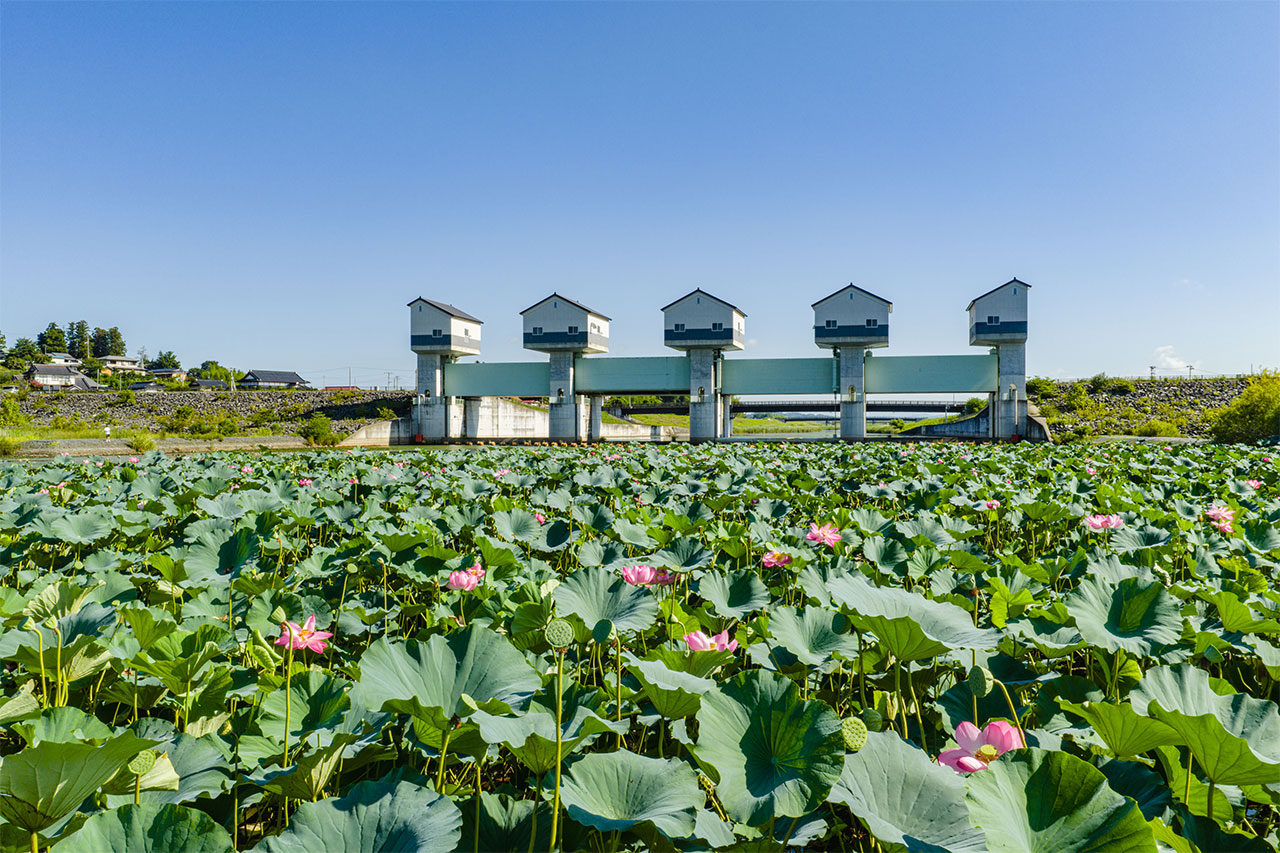
The project progressed while creating standards
Naganuma Dam was a new attempt to build a multipurpose dam on soft ground, a rare example in Japan, that utilized a natural lake as a flood control dam while also securing water for agricultural use in the surrounding area and creating a recreational space for citizens.
PACIFIC CONSULTANTS leveraged its strengths in having various department in-house, including grounds, rivers, roads, mechanical and electrical equipment, environment, etc. and became a hub that linked the efforts of the national and prefectural governments, research institutions, and academics, bringing together the knowledge and technology of dam construction in Japan to realize this difficult project. The pride that this project could only have been achieved by PACIFIC CONSULTANTS is also reflected in the acquisition of the naming rights to the "PACIFIC CONSULTANTS Naganuma Dam." It was an unforgettable job for each and every person involved. HIRATSUKA looks back on it this way.
"In the absence of technical standards, this project required me to observe phenomena, make judgments, set directions, and coordinate the overall project, and I learned a lot. Nowadays, we tend to think that anything that conforms to standards and guidelines is fine, but I think it's important to go back to the reasons why those standards were established in the first place, and to hone my skills while thinking for myself. Through my work on Naganuma Dam, I have developed the habit of thinking about the meaning of standards as I work."
It was also a new challenge for FUNAYAMA, who was in charge of the groundwork.
"Engineers today tend to be increasingly specialized. Some people can understand soft ground but cannot evaluate bedrock. I originally worked on deep underground such as dams and tunnels and other structures, so Naganuma was a completely different world, but it was a good experience that broadened my horizons as an engineer. Experiencing a variety of things broadens your ideas and improves your problem-solving ability. I would like young people to gain a variety of experiences as well."
OKAYA, who has been working at the Tohoku branch and has been involved with Naganuma Dam for over 20 years, also reflects that this experience helped him grow as a person.
"I've been in charge of river structures at the branch for a long time, but the scope of the Naganuma Dam was so broad that I was able to build my foundation as a river structure engineer through my work on the Naganuma Dam. I think I've become able to thoroughly consider the design conditions, standards, and structural details in my own way, and proceed while making sure that the project is really sound."
At the time, KOMORIYA was one of the youngest members of the company involved in the Naganuma Dam project, and joined the project when the design was almost complete, and was involved in test impounding and operation after completion. He says that there was a lot to learn while operating the dam.
"Because it is a multipurpose dam project, there are many aspects of operation that are different from those of ordinary dams or rivers. In order to derive an operation policy, we have to look back at the original design concept and consider the optimal solution. When creating an operation manual, there are no other examples to use, so we are working on finding the most realistic and best way. I was also in charge of creating a book that summarizes the history of Naganuma Dam from conception to completion. By poring over a huge amount of material, I was able to gain a deeper understanding of some technologies and also get to know the passion of the people involved."
The dam was built on soft ground, bringing together the wisdom of many people. It not only added a new chapter to the history of dam construction in Japan, but also left a great legacy for each of the people involved.




